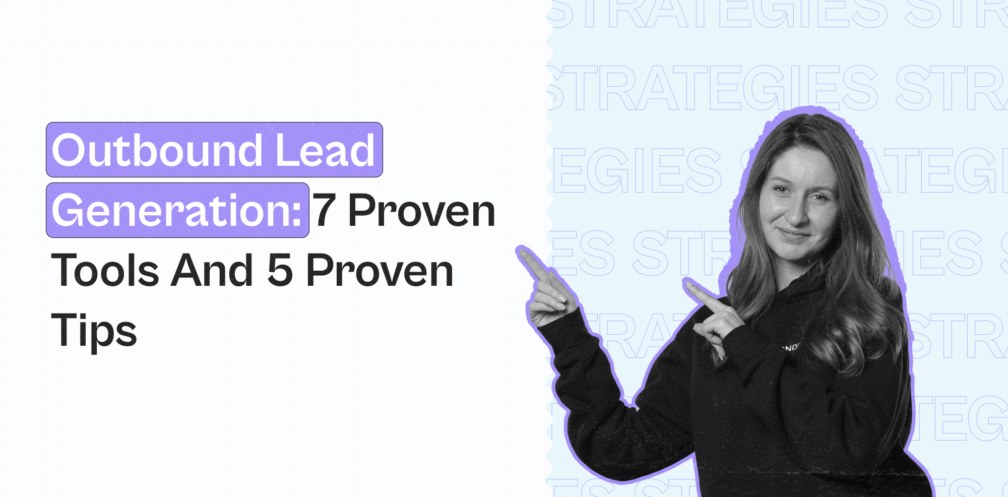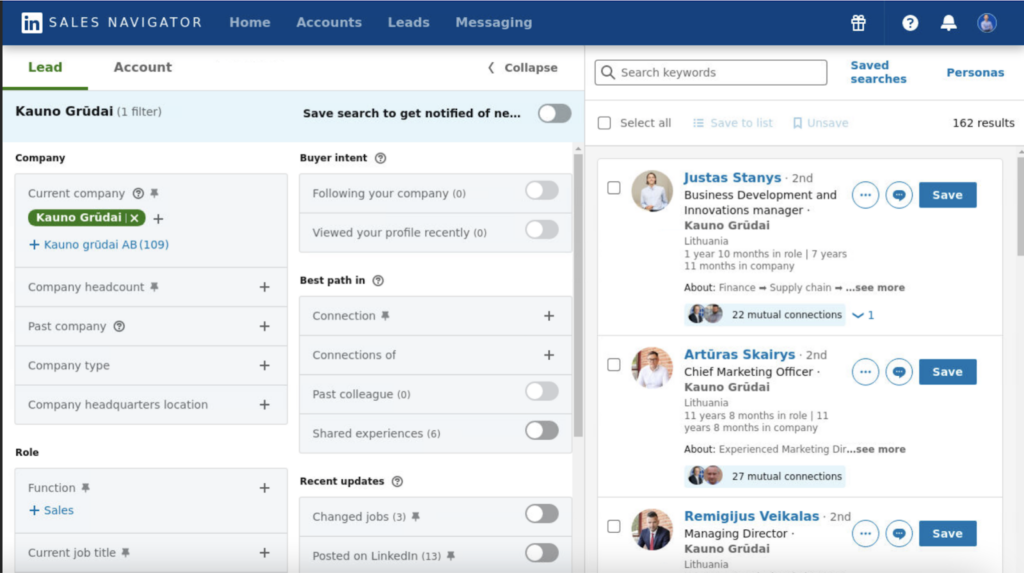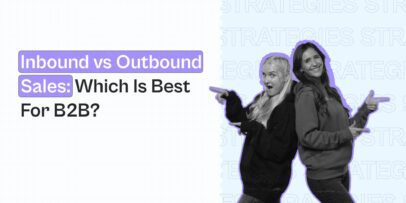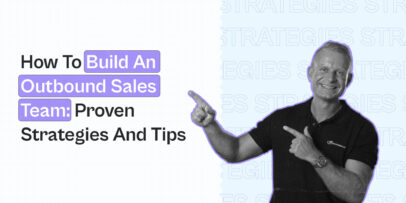Outbound Lead Generation: 7 Proven Tools And 5 Proven Tips

Outbound lead generation is the single best way to find potential customers who might not know about your business and convert them into paying customers.
Inbound marketing can take too long to kick in.
So, if you want to get paying customers ASAP, outbound is the way to go.
The downside, however, is that it can be quite tricky to figure out at first.
There’s cold calling, email outreach, LinkedIn, automation, and so much more…
Not to mention, so many different tools and strategies you can try.
Don’t worry though, if you’re looking to get started with outbound lead generation without getting overwhelmed, this guide’s for you.
Whether you work in B2B, SaaS, or some other industry, the tools and best practices we’ll follow below will be relevant regardless.
Here’s what you’ll learn:
- What is outbound lead generation and how does it work?
- 5 Proven outbound lead generation strategies and tips to get started
- Top 7 outbound lead generation tools
How Does Outbound Lead Generation Work?
With outbound lead generation strategies, you find a group of relevant leads and contact them with the objective of converting them into paying customers.
In other words, you go to your leads.
Inbound, meanwhile, is the opposite. As you try to get leads to come to you via SEO, content marketing, referrals, and more.
Outbound leads usually fall into 2 categories:
- A Marketing qualified lead (MQL) – Prospects who match your ideal customer persona. These leads could make good paying customers on paper as they’ve shown interest. Now, you need to investigate more or book a meeting to nurture them further.
- A sales qualified lead (SQL) – Leads who have been qualified by your sales team and are ready to continue the purchasing process.
Here’s an example.
- Prospect A replies to your cold email outreach campaign and shows interest in your solution. This is an MQL because they’ve shown interest but you don’t know their situation yet.
- Prospect B clicked on your case study link you messaged them and booked a call with your sales team. During the call, you discover they have the budget for your solution and the approval to move forward with it. This is an SQL
What does outbound lead generation involve?
Before getting started, typically, your outbound team should consist of:
- Sales development representatives (SDRs) – People researching, reaching out, and qualifying potential leads.
- Account Executives (AEs): These team members take over once a lead is qualified as an SQL. They are responsible for moving the lead through the sales funnel, handling product demos, negotiating terms, and closing deals.
- Outbound Marketing Manager: The person who oversees the strategy, tools, and overall execution of the outbound campaign. They ensure the team is using the right messaging, targeting the right audience, and utilizing the best tools for the job.
For a more detailed guide of this process from scratch, see our guide on how to build an outbound sales team.
Then, typically, outbound lead generation involves:
- Cold calling.
- Automated email outreach campaigns.
- Advertising.
- LinkedIn outreach, cold messages, and InMail.
- And more.
Finally, a typical outbound lead generation process looks like this:
- Start with defining your ideal customer profile. Research their pain points, characteristics, and how your solution can help them.
- Obtain their contact information through LinkedIn automation tools, organize extracted information into segmented lists.
- Verify contact information and emails with tools like Clearout and Zerobounce.
- Choose your preferred outreach tools to reach that audience. If you’re in B2B, this will be emails and LinkedIn.
- Set up an automated outreach campaign with tools like Expandi. Create a template and follow ups to nurture leads and get them to schedule meetings.
- After contact and meetings, continue nurturing leads, provide additional information, and address any other objections they might have. From there, guide them through your sales funnel and convert them into paying customers.
Now, this is an oversimplification, but when looking at your outbound lead generation process, the steps will usually look like the above.
All this though, will depend on your outbound sales strategy.
So, let’s explore proven processes you can get started with today and then, tools you’ll need to execute these strategies.
5 Outbound Lead Generation Tips For B2B SaaS And Other Industries
There is no point covering the marketing tools if you don’t know how to use them.
So, first, let’s go over some of the essential outbound lead generation tips you need to keep in mind before launching your campaign.
These tips are as follows:
- Identifying your target audience and segments.
- Creating a sales funnel.
- Generating leads.
- Choosing the right sales tools.
- Crafting a strong value proposition and outreach template.
Let’s get started.
1. Identifying your target audience and segments
Before diving into outbound lead generation, you need to know who you’re actually targeting.
This involves understanding who your ideal customers are, what their pain points are, and how your product or service can help solve their problems.
- Developing an ideal customer persona (ICP): Create a detailed profile of your ideal customer, including demographics, industry, job titles, company size, and specific challenges they face.
- Segmenting your audience: Not all leads are the same. Segment your audience based on factors such as company size, industry, or buying behavior to tailor your outreach accordingly. LinkedIn Sales Navigator (more info on this below) is ideal for this.
2. Creating your sales funnel
You need a well-structured sales funnel to guide leads through your buying process.
Here’s what you’ll need to focus on here:
- Targeted list: Use data and marketing tools to find customers that match yoru ideal customer profile.
- Create an effective message: Develop personalized messaging based on your audience’s pain points and needs.
- Reach out: engage potential customers through outbound methods like cold calling, cold email, and LinkedIn.
- Qualify leads: Screen potential customers using criteria like Budget, Authority, Need, and Timeline (BANT) to determine if it makes sense to work together.
- Set appointments: Schedule meetings or calls with qualified leads to discuss how you can help in more detail.
- Overcome objections: Address any concerns or objections, offering additional information or resources as needed.
- Close the deal: Finally, any details or contracts as needed.
3. Generating relevant leads for your solution
Lead generation is the backbone of any outreach campaign.
Without a steady stream of leads, your sales team will have nothing to work with.
So, here’s what you need to focus on:
- LinkedIn for prospecting: LinkedIn is the best place for B2B leads. You can use your free account to apply search filters (e.g. marketing agency owner in the UK) or even scrape LinkedIn groups.
- Cold email outreach: If you’re not connected with someone on LinkedIn, email is the second best bet. It’s important to craft personalized cold emails that speak directly to your prospects’ pain points. Keep on reading to learn how to automate this.
- Consider cold calling: Cold calling might seem intimidating at first. But it can be a great way to reach potential customers, even if you don’t know them. Equip your SDRs with a proven script based on common objections and highlight the value of your solution. Getting started with cold calling is easier than you might think. And because so many people focus on email and LinkedIn, you could even stand out this way.
- Social selling: Finally, if you’re already using LinkedIn for outreach, consider engaging with prospects there directly as well. Share relevant content, comment on their posts to stay on their radar, and establish a proper connection before making your pitch.
4. Choosing the right marketing and lead generation tech stack
You don’t need much to get started with outbound lead generation.
But these 3 lead generation tools will make your life much easier.
- CRM systems: A good customer relationship management system like Salesforce or HubSpot will help you track, manage, and organize leads throughout the sales funnel all in one place.
- Email automation: To reach a wider audience, you need to automate email outreach instead of emailing people one by one.
- LinkedIn automation: Just like email, you can fully automate this part with tools like Expandi. Then, you can send cold messages, connection requests, and follow-ups automatically to save time.
You can also use ChatGPT for lead generation across all stages of outbound.
5. Crafting a strong value proposition
Your value proposition dictates how well your outbound messaging will perform.
This statement explains why your product or service is the best solution for your prospects’ needs.
- Keep it clear and simple: Your value offer should be easy to communicate and understand. Focus on actionable and practical language, instead of vague, abstract benefits.
- Focus on benefits and outcomes: Highlight how your solution solves a specific problem or improves your prospects’ situation, rather than just listing features. If possible, also list out specific outcomes, like “booking 4 new meetings on average” instead of “helping with lead generation”.
- Tailor your messaging: Finally, adjust your language based on the segment you’re talking to. Consider their challenges, goals, and how you can help. Case studies and social proof are also ideal for this.
Now, to succeed in outbound lead generation, you need the right set of tools.
So, let’s take a look at the essentials.
Top 7 Tools For Outbound Lead Generation Strategies
Below, we’ll cover some of the best tools for this, their pricing, use cases, who they’re for, and more.
The outbound lead generation tools we’ll cover are as follows:
- LinkedIn Sales Navigator.
- Expandi.
- HubSpot CRM.
- Clay.
- TexAu.
- Apollo.io
- Folderly.
1. LinkedIn Sales Navigator

If you work in B2B, Sales Navigator is the single best tool in your arsenal to find, manage, and reach leads on the platform.
While you can use the free LinkedIn account to get started, it’s very limited.
Meanwhile, Sales Navigator offers a ton of advanced features to find your ideal clients on the platform, no matter their niche or size.
Key features:
- Advanced lead and company search: Apply over 30+ search filters to zero in on your ideal client profile. Including their industry, job title, company headcount, recent updates, buyer intent, and more.
- Lead recommendations: Based on your preference and search history, Sales Navigator can recommend potential leads you might have missed.
- InMails messaging: Reach out to prospects directly in their inbox, even if you’re not connected. InMails can be a great way to cut through the noise if someone hasn’t replied to your regular message or accepted your request.
- CRM Integrations: Sync seamlessly with your CRM to keep your prospect data organized and up-to-date. Then, you can launch automated campaigns (see how below) depending on the status of your leads.
Pricing:
- LinkedIn Sales Navigator starts at $79.99 per month for individual users. Note this may also depend on your location.
Use cases:
- Prospecting and lead generation.
- Account-based marketing (ABM).
- Market research.
- Hiring.
- Sales outreach.
2. Expandi
Expandi (that’s us!) is a LinkedIn automation tool to help scale your outreach efforts without compromising on personalization or safety.
The tool is simple.
Instead of using 3 different tools for your LinkedIn, email, analytics, and more…
You can just use Expandi to scrape audiences, create outreach campaigns, see how they’re performing, and so much more.
Making it ideal for lead generation, sales and marketing teams, recruiters, and more.
Key features:
- Automated outreach: Send connection requests, cold messages, and follow-ups on autopilot in the background.
- Dynamic personalization: Create personalized messages with custom fields and variables to ensure each interaction feels unique. You can take this a step further and use dynamic images and GIFs to really stand out.
- Smart sequences: Build and launch multi-step outreach campaigns based on “if-this-then-that” conditions.
- Analytics and reporting: Track your campaign performance with detailed analytics and optimize your strategy based on data, instead of guessing.
Pricing:
- Expandi starts at $99/mo with a free, 7-day trial.
Use cases:
- Large-scale outreach: Import or target leads with large-scale outreach campaigns across multiple touch points (LinkedIn, InMails, emails, and more).
- Omnichannel outreach: You can launch multi-channel campaigns across LinkedIn and emails in one place, instead of using different tools.
- Lead nurturing: Set up smart sequences to keep your brand top-of-mind for prospects who are not ready to buy yet.
- Scraping: Scrape LinkedIn search results, groups, event attendees, and more. Then, use that for outreach as needed.
- White label: Ideal if you’re an agency managing over 20 accounts. Learn more here.
3. HubSpot CRM
HubSpot CRM is an ideal starting place if you don’t need anything very fancy.
This free and user-friendly CRM provides a ton of tools and features for small to mid-sized businesses, sales, and marketing teams.
Key features:
- Contact management: Store and manage your contacts in one centralized database.
- Tracking and automation: Send personalized emails, track opens and clicks, and automate follow-up sequences based on lead statutes.
- Pipeline management: Visualize your sales pipeline and track deals as they move through your sales funnel.
- Integration with other HubSpot tools: If you’re using other HubSpot lead generation or marketing tools, you can integrate them for free at a click.
Pricing:
- HubSpot CRM is free to use with paid upgrades available for advanced features.
Use cases:
- Managing leads: Keep track of your leads, their interaction, and where they are in your sales funnel.
- Sales automation: Automate routine tasks like follow-ups and reminders.
- Lead generation reporting and analytics: Get detailed reports on your sales activities, team performance, and pipeline health.
4. Clay
Clay is a multi-source enrichment and personalization tool for sales and marketing teams.
Clay connects you with 75+ data providers to take your outreach to the next level.
Key features:
- Data enrichment: Clay can enrich contact data with additional details such as job titles, company information, social media profiles, and more.
- Custom workflows: Set up custom workflows based on trigger actions and data changes. For example, you can send personalized emails with a contact’s job title changes or when they join a new company.
- Personalized outreach: Use Clay’s AI message writer to help draft personalized messaging that resonates with your prospective customers.
Pricing:
- Free: 14-day trial.
- Starter: $149/mo at 2,000 credits/mo.
- Explorer: $349/mo at 10,000 credits/mo.
- Pro: $800/mo at 50,000 credits/mo.
- Enterprise: Individual pricing.
Use cases:
- Automated inbound and outbound: Enrich, score, and message leads with personalized messages.
- List building: Build targeted lead lists from various sources with Clay and manage them in one place.
- CRM enrichment: Automate CRM enrichment with Clay. Sync with major CRM platforms, gain access to 50+ data providers for lead information, and use custom formulas to clean and format CRM data.
5. TexAu
TexAu is a powerful growth automation tool designed to help you generate and reach new leads from different sources. Including LinkedIn, Twitter, Facebook, and more.
Key features:
- Data scraping: Scrape data from different social media channels, groups, and posts. Ideal if you’re using this in combination with Expandi or other outbound lead generation tools.
- Automated workflows: Create custom workflows to automate tasks such as sending connection requests, follow-up messages, and extracting contact information.
- Multi-platform integrations: Integrate TexAu with your other lead generation tools like to streamline outreach.
Pricing:
- Starter: $79/mo.
- Teams: $199/mo.
- Agency: $459/mo.
Use cases:
- Outbound lead generation: Automate certain engagement tasks such as liking posts, following accounts, and more.
- Data scraping and enrichment: Enhance existing contact lists by using TexAu to gather additional data points or simply scraping audiences from different channels.
- Outreach campaigns: Finally, you can also set up automated outreach campaigns to reach your target audience.
6. Apollo.io
Apollo is another essential outbound lead generation tool for data enrichment, automation, and finding relevant leads.
Just like Sales Navigator, you can filter for and find leads with Apollo.
Key features:
- Prospecting database: Apollo offers a vast database of over 200M+ contacts to find and target potential leads.
- Data enrichment: Enrich your contact list with additional data points such as job titles, company size, industry, and more.
- Email sequencing: Then, automate your outbound lead generation with customizable email sequences.
- CRM integrations: Just like any other important outbound lead generation tool, you can integrate Apollo with your CRM to keep your data up-to-date.
Pricing:
- Free: Limited features and credits.
- Basic: $49/per user/mo.
- Professional: $79/per user/mo.
- Organization: $119/per user/mo.
Use cases:
- Prospecting: Leverage Apollo’s extensive database to find potential customers based on specific criteria.
- Outreach: Set up automated email sequences to nurture leads and keep them engaged through your sales process.
- Data enrichment: Improve the quality of your contact data to ensure your outreach is accurate and personalized.
- Cold calling: Leverage in-built dialer to manage call campaigns and track lead interactions.
7. Folderly
If you’re going to be using email as part of your outreach, you need an outbound lead-generation tool like Folderly.
Folderly is an email deliverability platform designed to help businesses improve their email outreach and performance.
This is mainly for businesses heavily investing in email outreach.
Key features:
- Email deliverability audit: Perform comprehensive audits of your email accounts to identify any issues that might be affecting your deliverability. Such as blacklisting, poor IP reputation, or incorrect DNS settings.
- Spam fixing: Fix spam-related issues and ensure your emails go into your audience’s inbox and not the spam folder.
- Email warm-up: Warm up a new email address to build a positive sender reputation before doing outreach.
- Real-time monitoring and analytics: Keep track of your email deliverability with real-time monitoring and reporting.
Pricing:
- 1-9 mailboxes: $96 per mailbox/mo.
- 10-24 mailboxes: $72 per mailbox/mo.
- 25-99 mailboxes: $56 per mailbox/mo.
- 100+ mailboxes: Custom price.
Use cases:
- Improve email deliverability: Ensure your outbound emails land in your audience’s inbox by addressing common deliverability issues.
- Email warm-up: Warm up new email accounts before doing outreach to avoid being flagged by spam filters.
- Campaign optimization: Monitor and improve email performance in real-time based on data instead of guesswork.
Conclusion
So, to recap, the outbound lead generation tools we covered for different use cases are as follows:
- LinkedIn Sales Navigator – finding your target audience to reach out to on LinkedIn.
- Expandi – creating automated outbound lead generation and outreach campaigns at scale.
- HubSpot CRM – Managing leads and keeping track of them as they go through your sales funnel.
- Clay – Enriching and personalizing leads across multiple data points to enhance your outreach.
- TexAu – scraping audiences and automating actions.
- Apollo.io – Finding, scraping, and enriching audience segments.
- Folderly – Warming up your email account before outreach and auditing your deliverability.
Looking to take your outreach to the next level?
You can scrape LinkedIn search results, groups, and even webinar attendees with Expandi…
Once you launch your first campaign in under 15 minutes, you start seeing results in under 24 hours.
So, you can claim your free, 7-day Expandi trial here and gain full access to the tool to start your outbound lead generation now!
You’ve made it all the way down here, take the final step


